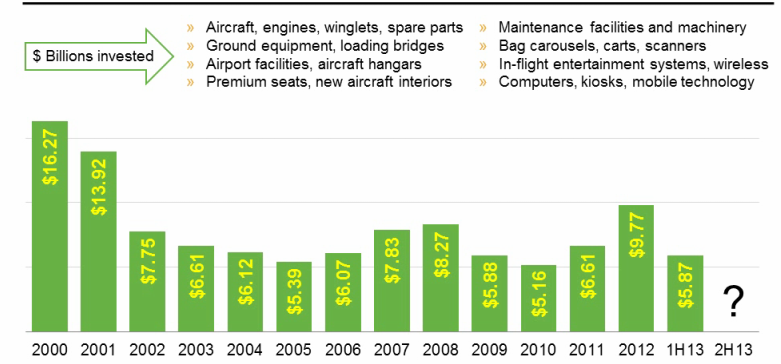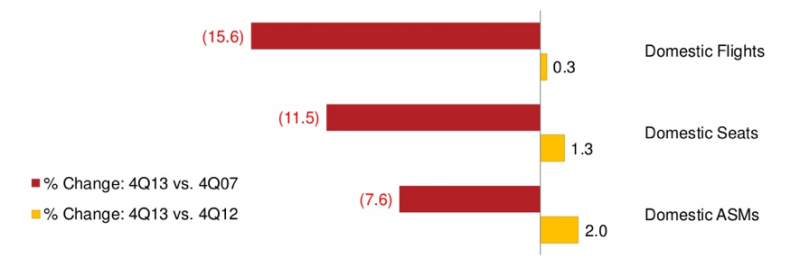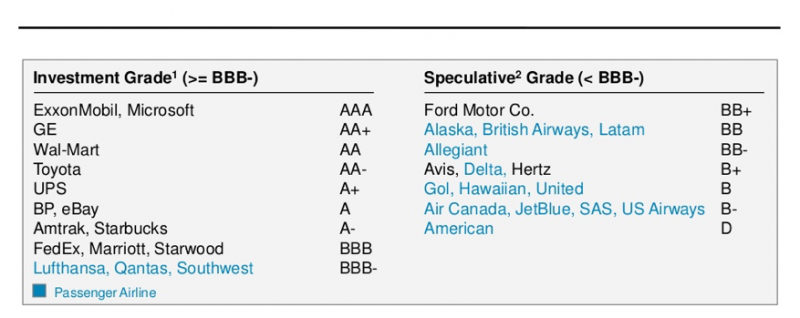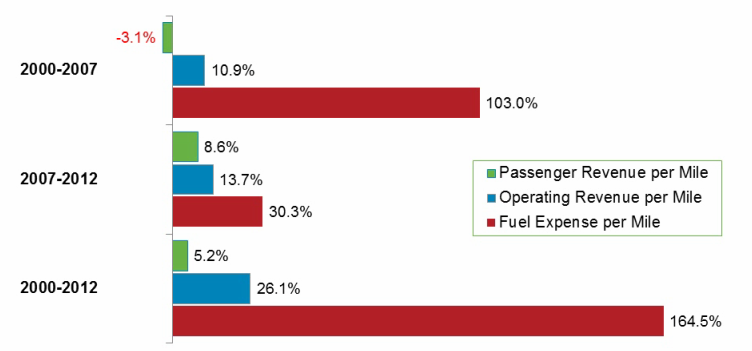US airlines make financial progress in 1H2013, but fuel cost pressure remains a constant overhang
US airlines continued to make solid financial gains during 1H2013, growing margins to 2% compared to 1.6% the year prior. While those results would make executives in any other industry squirm, the increase reflects some progress the industry has taken to change business fundamentals to produce consistent profits.
Now the challenge will be to sustain and grow profits through an entire business cycle that does not include the benefits of Chapter 11 reorganisation and the positive effects of industry shrinkage through consolidation. With fuel prices remaining just as volatile as during the last five years and no end in sight for the taxation facing the industry, perhaps a shift in thinking is necessary to make the transition from simply surviving to thriving. History suggests that simply making profits may not be the best environment for sharpening that edge.
The slight improvement from razor thin to paper thin margins is, surprisingly, progress!
US trade group Airlines For America (A4A) admitted the margins produced by the 10 airlines whose performance it tracks (Alaska, Allegiant, American, Delta, Hawaiian, JetBlue, Southwest, Spirit, United and US Airways) moved from razor thin to paper thin during 1H2013.
US airline financial results: 1H2013 vs 1H2012
Examining various metrics from 2000, 2007 (when the global recession started and fuel prices started their rise to historic highs) and 2012 (when fuel prices again reached an all-time high), A4A data show that the portion of air fare necessary to cover fuel expense has jumped from 15% to 38% between 2000 and 2012 while break-even load factors have risen from 69% to 81%.
So even as airlines are operating at record high load factors, those levels are necessary just to achieve modest profitability. Data released from the US Department of Transportation on 22-Aug-2013 show that US carriers averaged a system-wide (domestic and international) load factor of 82% and 83% for scheduled domestic air travel.
US airline financial inputs: 2000, 2007 and 2012
While airlines have taken both operational measures and changes to their hedging strategies, which in some cases include abandoning hedging altogether, to cope with fuel price volatility, the reality is fluctuating fuel costs will continue to hammer the industry. And there seem to be few options left to reasonably control the industry's most vexing cost input.
Delta perhaps deserves some innovative credit for sticking its neck out and buying a refinery to exert more control over its fuel costs, but a year after its Trainer facility opened for business, the results are disappointing.
See related report: Delta Air Lines' oil refinery investment losses concern sceptical investors and observers
The US industry was arguably forced to make itself more nimble
But as A4A rightly points out, during the last few years the US industry has made itself more nimble to cope with fuel price shocks and macroeconomic pressure after the global economy imploded during 2007. Since then the industry has taken a massive restructuring, which was arguably necessary and ushered in only by a global economic meltdown and sky rocketing fuel costs.
A4A believes the industry is never insulated from exogenous shocks, but since 2007 the business is now better insulated to withstand those events, which now can be viewed as a threat to earnings rather than a threat to existence.
US airlines invest aggressively in product after letting some elements languish
As the first shreds of stability emerge in the US airline industry after a decade-plus of rebuilding, the country's airlines are finally making necessary product investments, reflected in A4A's estimate that capital expenditures during 1H2013 reached nearly USD6 billion or USD1 billion per month. Based on that trend, capex for 2013 could outpace the nearly USD10 billion spent in 2012, which was the highest level of expenditure since 2001.
US carrier capital expenditure: 2000 to 1H2012
The spending runs the gamut from onboard equipment installation to support Wi-Fi and other in-flight entertainment systems, new business and premium economy seats, and new aircraft themselves.
Carrier rationale for the spend beyond the obvious requirement to have service levels at least close on par with global airlines is that improving balance sheets have allowed for the investment. Although it is questionable if enough de-leveraging has occurred to a point that warrants significant capital expenditure, a new focus on return on invested capital within the US industry should ensure carriers carefully scrutinise their investments as they recognise their relatively new levels of profitability require a heightened sense of responsibility to shareholders.
A4A made an interesting comparison between the airline industry and other companies to illustrate the renewed level of capex spend by US carriers. Margins at Apple, Ford and Starbucks were higher than those recorded by US airlines, yet the capital spend at those companies was well below the outlay carriers made during 1H2013.
While all companies have lulls in capital expenditures, arguably those firms did not take as long a hiatus from capital investment as US airlines, who were forced to duck their heads and enter Chapter 11 during the last decade to reverse years of irrational behaviour.
US airline capital expenditure compared with Apple, Ford and Starbucks: 1H2013
New-found stability is leading to an uptick in domestic capacity
US carriers are also planning a slight increase in domestic capacity, according to A4A data. The association estimates that available seat miles will grow 2% year-on-year during 4Q2013, driven by the start of modest returns on capital and a somewhat improving economic climate.
Based on the association's data, domestic capacity has been rising modestly throughout 2013, which should not be cause for immediate concern given the improvements in profitability year-on-year during 1H2013, and the increase in 2013 is still below capacity expansion recorded in 2007.
US carrier domestic flight, seat and ASM change 4Q2013 vs 4Q2007 and 4Q2013 vs 4Q2012
US Airline change in domestic daily seats: 1Q2008 to 4Q2013
However, as fuel costs rise capacity is the first lever most carrier reach to pull in order to stave off the effects of higher energy expense. So it will be interesting to see what the final statistics show. But schedules for the rest of 2013 are pretty firm, so the theory that rising revenues is parallel to rising fuel costs needs to mesh with the increased supply in the marketplace.
The US industry still has a long distance to travel to brandish an investment grade label
Despite commendable progress in creating a somewhat sustainable business model, the US industry has a long road ahead to collectively reach investment grade.
As A4A stated: "The airlines' financial condition has improved but remains far from stellar." Based on S&P calculations, only one US carrier, Southwest Airlines, has investment grade credit, while eight carriers are classified as speculative.
S&P companies with investment and speculative grade status
Prior to its merger with TAM, LAN was investment grade, but with the depreciation of Brazil's currency and other challenges have made LATAM Airlines Group highly leveraged, and hopes to regain investment grade status within three years. That scenario reflects some of the significant risks a carrier take upon merging.
United Airlines has also backed off on its target of achieving USD1 billion in merger synergies during 2013, indicating it is reasonable to assume reaching that goal could not occur until 2014.
See related reports:
- LATAM Airline Group's merger anniversary marked by USD300 million loss in tough operating dynamics
- United looks for a brighter 2013 as investors await promised merger synergies
Delta believes it will meet its previously set target of USD10 billion adjusted net debt by YE2013, and has set a new goal of USD7 billion. Delta concluded that was a reasonable target after studying debt levels that could possibly lift the carrier to "investment grade-like credit metrics", the carrier's management has previously concluded.
Taking a wide view of the US airline industry progression during the last few years, the surviving carriers should be commended for the gains they've made in creating a path to stability. But now their responsibility is to lay out a foundation to sustain the new-found sturdiness during the next few years to show the fundamental structural changes they often tout are a permanent fixture.
In past cycles, the accent on cost management and efficiencies has significantly diluted as profits rose. Maintaining a focus on that side of the ledger will be the major test of whether airline managements are now up to the task of establishing sustainable businesses.
Background information
US carrier passenger revenue, operating revenue and fuel expense per mile: 2000-2007, 2007-2012 and 2000-2012
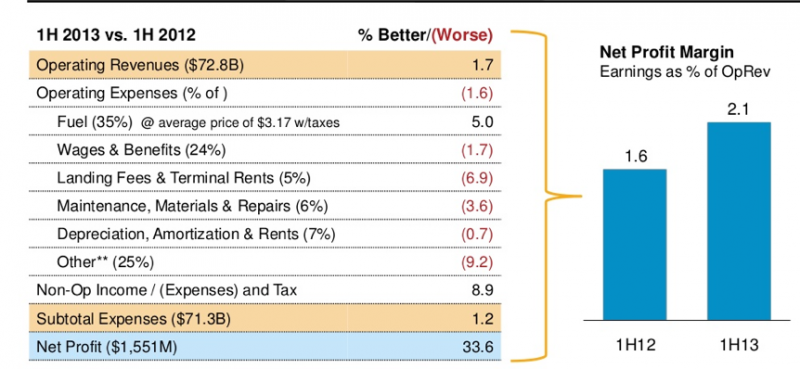
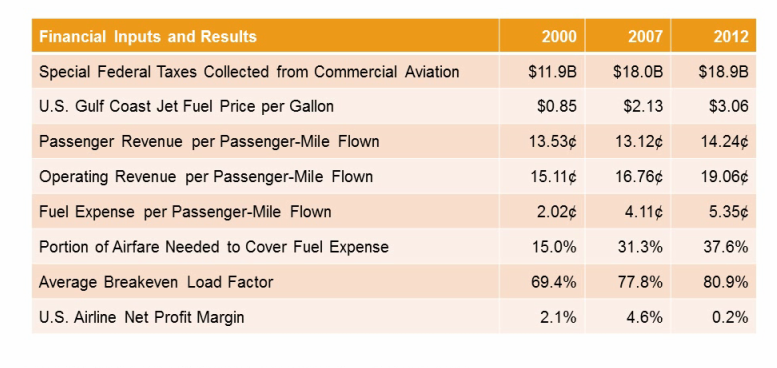 777" height="368" />
777" height="368" />
